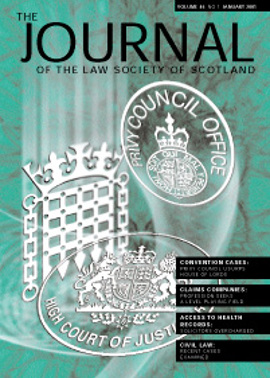President’s report
Should the Society relocate?
The Society is often seen as being too “Edinburgh-centric”. Drumsheugh Gardens has an old-fashioned image which does not reflect the modern, hardworking organisation at number 26. There is also the overheating of the Edinburgh economy which affects both commercial and domestic property. Cost of transport in and around Edinburgh is high as are rates bills. More members of the Society’s staff than ever before live outside Edinburgh and housing cost must play a large part in this.
It is not essential for the Society’s office to be based in the centre of any city, but it does need to be conveniently placed for access by public transport, particularly the rail network. At present the parking facilities are inadequate.
The office space is arguably sufficient for the time being, but it is beginning to bulge at the seams and it has been described as a series of “rabbit warrens”. It is an old building previously used as housing, and is not therefore convenient for routing of cables for telephones, IT, etc. Working spaces are not flexible. It provides a fairly poor location and facilities for Update, one of the Society’s most important services to its members. Storage space is limited and the facilities for visitors, whilst adequate, could be better. If the Society were able to start with a clean sheet, it could have a purpose built modern office, as the Institute of Chartered Accountants in Scotland have recently created, and could find a site with considerable scope for development, providing space, for example, for our own law school.
On the other hand, the Society’s headquarters should be handily placed for all the work we do at the Scottish Parliament. It is also convenient to be near Parliament House, but then Drumsheugh Gardens is not really all that well located for either the Parliament or the courts. There is a feeling on the part of many that the Society should be at the heart of Scottish civic life. Whether we like it or not the Society is seen as part of the establishment, and on one view this enhances the profession’s credibility and importance. Some feel that this is reinforced by having an office in the West End of Edinburgh. Having said that, others may well feel that the establishment image is actually a weakness rather than a strength.
Another argument in favour of staying at Drumsheugh Gardens is that IT should make the Society more accessible to its members - wherever they live and practise - without requiring physical relocation. High Edinburgh property values make the present building a good investment. Any move would cause some disruption to staff, and there is also the simple cost of moving to a new base.
What are the options?
A number of alternatives present themselves. First of all, obviously, the Society could stay put. Another possibility might be to re-locate within Edinburgh but away from the expensive city centre. Moving lock, stock and barrel to an entirely different location – probably still somewhere within the central belt of Scotland – is another realistic option. Relocation, whether within or outside Edinburgh, would provide an opportunity for the Society to let out its current premises and achieve relatively high rental income which might fund the taking on of modern premises.
There is also the possibility of a partial re-location, maintaining some sort of presence in Edinburgh, but moving many functions elsewhere. Some might see this as a welcome opportunity to physically separate those functions involving regulation of the profession from the provision of services to members. However, this may harm the strong spirit of teamwork currently prevailing in the organisation, and the splitting of these functions might be seen as poor business practice. Alternatively a smaller “ceremonial” building might be retained in Edinburgh with all the Society’s operational functions moving to more cost effective premises and perhaps even using remote working with employees working from home.
A final option might be to establish a branch office or offices elsewhere in Scotland while retaining the Society’s principal functions in central Edinburgh. This would achieve a heightened presence in say Glasgow and/or Aberdeen and it would certainly improve communication if there was an office on the doorstep rather than all communications having to come from Edinburgh. Facilities in such a branch office could be relatively modest and still enable Committee meetings to take place there with video and audio links to Edinburgh. Such an arrangement might well bring about substantial savings on the time given by Council and Committee members as well as on the relative expenses.
I hope these options will come before Council for a decision in principle within the next few months. However, the input of you, the members, will be of huge importance in helping the Council reach its eventual decision, and so I would very much welcome contributions from any reader on this issue. Please write to me direct at the Law Society of Scotland or e-mail me at alastairthornton@lawscot.org.uk.
In this issue
- President’s report
- Judicial politics in the Judicial Committee
- Modern code for adults with incapacity
- Competition law compliance: role for profession
- Hearsay: admissibility revisited
- Excessive costs of acessing health records
- Level playing field sought for injury claims
- Making websites do things
- Focus on commercial property risks
- EU employment law update
- Book reviews






